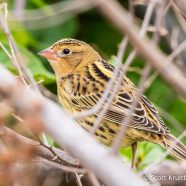Gray Ghost & Winter Raptors
We are now in the beginning of meteorological winter and nearing the start of astronomical winter. Our birds, as usual, are already prepared for the season however we wish to define it, having migrated, irrupted, or dispersed to wintering grounds throughout the region, continent, or perhaps even out of our hemisphere. Those that remain with us have evolved to cope with the freezing conditions and heavy snowfall. One such species is the Northern Harrier, and last week I photographed this adult male “gray ghost” while it was hunting. Look at that gaze – magnificent! The Roger...
Read MoreField Sparrow
The Field Sparrow (Spizella pusilla) is an underrated little bird! Look at that bold eye ring and those beautiful brown tones with a pretty pink bill. Whenever I see those Fields in numbers in October it always suggests we are nearing the end of autumn avian migration. If we are lucky we may be able to spot one or two overwintering in the region, perhaps on a Christmas Bird Count, but most will be seeking less snowy quarters so they can enjoy easy to reach seeds all winter long. Nevertheless, if there aren’t any fields, grasslands, farms or other open areas – or if these habitats...
Read MoreFall Bobolink
This Bobolink (Dolichonyx oryzivorus) was a beautiful sight for the first day of October as it fed on seeds with sparrows, especially once it allowed this great a look. Keep an eye on your fields, grasslands, gardens and farms for more birds like this one still heading out and other new migrant species – like the Vesper Sparrow – arriving soon.
Read MoreMigrant Eastern Kingbird
Here’s an Eastern Kingbird (Tyrannus tyrannus) ruling over a field in migration while snatching up all sorts of flying insects. The healthier our grasslands and open areas are the healthier our birds like this one will be for a prolonged migration between continents.
Read MoreWestern Sandpiper (Calidris mauri)
Fall shorebirding can be very rewarding in a number of diverse habitats including farm fields, parking lots with pools of water, muddy pastures, grasslands, beaches, and rocky shorelines. Whether they are foraging, preening, or roosting there are always good chances to examine shorebirds for prolonged periods. That does not mean the task of identifying them will be easy! For every readily identifiable bird like the American Oystercatcher there seem to be a few difficult to discern species. The juvenile Western Sandpiper (Calidris mauri), as seen below and photographed in late August, can be...
Read More








